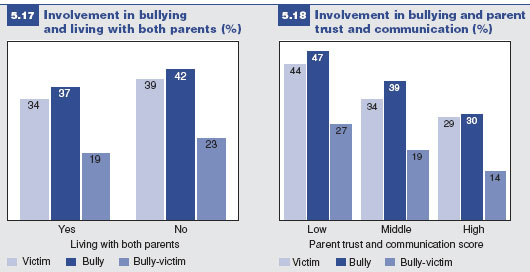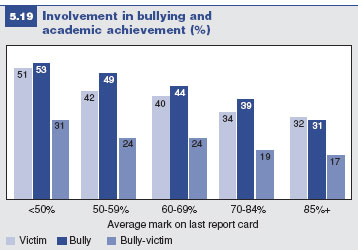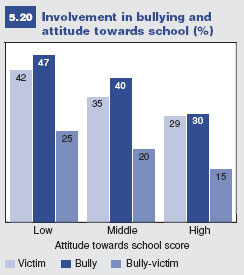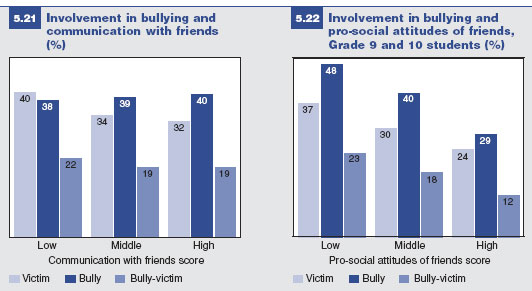Common menu bar links
Institutional links
Diseases & Conditions
Health & Safety
Research & Statistics
Agency Information
Search Box
Healthy settings for young people in Canada
Previous | Table of Contents | Next
Bullying in Context

Figure 5.17 indicates that young people who live with both parents are less likely overall to be involved in bullying in all three categories.
There are also significant linkages between relationships in the family and involvement in bullying, as indicated in Figure 5.18. Young people with lower scores on the parent trust and communication scale are more involved as victims, bullies, and bully-victims.


Young people who report lower academic achievement levels or who report negative feelings about the school environment, based on the attitude towards school scale, are more likely to be involved in bullying (Figures 5.19 and 5.20).

Notably, there are mixed results regarding the peer context and bullying. Middle to high level of communication with friends is associated with lower chances of being a victim; for example, 32% of those with a high score on the communication with friends scale are victims, compared to 40% of those with a low score (Figure 5.21). Quality of communication with friends does not, however, impact on being a bully or bully-victim.
In contrast, Figure 5.22 shows a protective pattern of higher scores on the pro-social attitudes of friends scale, suggesting that young people who report having friends with higher levels of pro-social attitudes are much less likely to be involved in all three categories of bullying.
Taken together, Figures 5.21 and 5.22 suggest that the attitudes of friends are more consistently important in bullying than their level of communication. Having a low communication with friends score is related to being a victim, but not to being a bully.


 Family affluence does not appear to affect
whether young people are victimized
(Figure 5.23). In contrast, young people
with higher scores on the family affluence
scale are more likely to be bullies.
Family affluence does not appear to affect
whether young people are victimized
(Figure 5.23). In contrast, young people
with higher scores on the family affluence
scale are more likely to be bullies.

Summary
There are several important messages from this examination of bullying and fighting behaviour. First, bullying remains a significant problem in Canada, with an alarming proportion of young people reporting involvement in bullying either as the aggressor, victim, or both. Since 2002, most forms of bullying have decreased, although racial harassment of both boys and girls has increased, especially in primary school grades. The way that children and youth are victimized differs by gender. Boys are more likely to be victimized by physical and verbal bullying, whereas girls are more likely to be victimized by indirect and cyber bullying. Sexual harassment is higher for boys than girls in Grades 6 and 7, while the opposite is true in Grades 9 and 10.
Fighting behaviour as reported by young people has increased since 2002, especially in lower grades. Although more boys report fighting than girls, there are also notable differences in whom they fight with. For example, boys are more likely to fight with strangers, whereas girls are more likely to fight with those they know.
Across all categories of bullying, there are clear contextual associations with problems at home, at school, and in the peer group. Taken together, these findings highlight the need to take significant broad-based actions to address this public health problem of bullying and violence. Our current efforts do not suffice, as the problems are not diminishing sufficiently with time.
If we are to be effective in addressing these problems, interventions need to take a systemic approach and be designed to support young people in all the contexts in which they live, work, and play. Through designing interventions that go beyond the school and actively involve families and communities, we may be able to create environments that are more supportive of young people involved in bullying.
References
1 McMaster, L., J. Connolly, D.J. Pepler, and W.M. Craig (2002). Peer to peer sexual harassment among early adolescents. Development and Psychopathology, 14:95-105.
2 Farrington, D. (1993). Understanding and preventing bullying. In M. Tonry and N. Morris (eds.), Crime and Justice, 17:381-458. Chicago: University of Chicago Press.
3 Olweus, D. 1992. Victimization by peers: Antecedents and long-term outcomes. In K.H. Rubin and J.B. Asendorf (eds.), Social Withdrawal, Inhibition, and Shyness in Childhood, pp. 315-341. Hillsdale, NJ: Erlbaum.
4 Same reference as in note 2.
5 Olweus, D. (1991). Bully/victim problems among school children: Some basic facts and effects of a school-based intervention program. In D. Pepler and K. Rubin (eds.), The Development and Treatment of Childhood Aggression, pp. 411-448. Hillsdale, NJ: Erlbaum.
6 United Nations (1989). The Convention on the Rights of the Child. Geneva: UN.
7 Craig, W.M., and Y. Harel (2004). Bullying, physical fighting, and victimization. In C. Currie, C. Roberts, A. Morgan, R. Smith, W. Settertobulte, O. Samdal, and V. Barnekow Rasmussen (eds.), Young People's Health in Context: International Report from the HBSC 2001/02 Survey, pp. 133-44. WHO Policy Series: Health Policy for Children and Adolescents, Issue 4. Copenhagen: WHO Regional Office for Europe.
